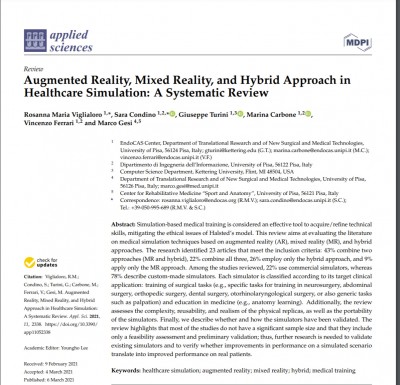About RKA
This author has not yet filled in any details.So far RKA has created 8 blog entries.
The Post Zoom World
There’s an interesting take over at recode on Zoom fatigue and the pandemic-forced trend towards geographically distant but still face-to-face interaction, aka telepresence. 
Even after the pandemic ends, video chat will play an increasingly important role at work, for school, in health care, and in our relationships with friends and family. The pandemic not only pushed this technology into new scenarios of our daily lives but also forced people to learn how to use it. Folks that hadn’t tried Zoom, FaceTime, or Google Meet before March became power users in record time. Some of these new users have even embraced the software’s virtual backgrounds and AI-generated face-smoothing effects. (The software is extremely easy to use now compared to 15 years ago, when I first used it.) While few of us want to keep doing Zoom happy hours after the pandemic ends, more of us are comfortable using it than ever before.
Further:
But as we’ve learned from Zoom’s periodic meltdowns, repurposing office software for our social lives is a tricky business. Part of why we have felt fatigue from video calls during the pandemic is because the technology was designed for a different purpose than having virtual happy hours or hosting graduation parties. It’s even worse if you’re using the same laptop for work calls and fun times. Little tweaks like virtual backgrounds and fun filters help liven things up, but the next generation of the social network would really benefit from some new hardware.
Taking telepresence to the eventual next level will require new thinking focused on ubiquitous, easy experiences and minimal technical acumen on the part of the users. If we expect geographically displaced individuals to connect – personally – we have to make that experience as easy as an in-person engagement. Easier, actually, since that’s where the value proposition lies. Creating experiences that are easier, smarter, and less burdensome while managing to truly connect people, their ideas, and their feelings in a truly personal way.
That’s the innovation opportunity.
Goodhart’s Law
Goodhart’s Law is named for Charles Goodhart, a British economist who in 1975 popularized the idea that
Any observed statistical regularity will tend to collapse once pressure is placed upon it for control purposes.
I think it was meant humorously, but the pungent truth of the statement made it stick.
The point is sound. Essentially, any statistic that becomes a target ceases to be a good measurement.
Chasing a statistic causes people and organizations to ignore the unintended or secondary/tertiary/etc. consequences, which may, in fact, MATTER A WHOLE LOT.
Prranshu Yadav has a good post featuring four “profound ways that Goodhart’s Law subtly affects your life.” I suggest reading his sage post.
Goodhart’s Law, and its impacts, can be seen all over the place. If you pay attention to what appears to matter, from a quantifiable standpoint, you will see it in action everywhere.
One universal system that everyone engages at some point in their life is healthcare. Healthcare systems live and die by their metrics. Optimizing against a metric, such as reducing patient readmissions, might end up having unintended consequences. Mayo Clinic defines hospital readmission as patient admission to a hospital within 30 days after being discharged from an earlier hospital stay. The standard benchmark used by the Centers for Medicare & Medicaid Services (CMS) is the 30-day readmission rate.
Of course, we need to reduce readmissions. Makes sense, right?
However, when held accountable for readmissions, hospitals tend to over focus on the measurement at potential expense to other programs and needs. To reduce admissions, a hospital may preventing needed patient readmissions (not admit a patient that needs care) or assign a majority of the doctors to the emergency room at the detriment of other hospital areas in an effort to get the diagnosis correct.
Keep your eyes open for examples of Goodhart’s Law in action. You will be astounded by what you find.
Looking for the Next Steve Jobs? Have Your HR Team Ditch AI
 The point: today’s AI programs wouldn’t choose Steve Jobs for the job/jobs he had. The AI programs in use today are really filter and high level analysis tools. There is an opportunity to forge a new way of measuring people that leverages both AI and the intangible traits that likely matter equally, if not more, than the things on paper.
The point: today’s AI programs wouldn’t choose Steve Jobs for the job/jobs he had. The AI programs in use today are really filter and high level analysis tools. There is an opportunity to forge a new way of measuring people that leverages both AI and the intangible traits that likely matter equally, if not more, than the things on paper.
Resumes aren’t typically worth much more than a few minutes of your time, and yet Steve Jobs’ 1973 resume sold for $174,000 as if it were a piece of art–and in many ways it is. But it’s not its poetic allure of his hurried handwriting or the comedic indifference in Jobs’ responses that make it worthy of six figures.
Source: Looking for the Next Steve Jobs? Have Your HR Team Ditch AI
HARPA = Advanced Research Projects Agency for Health
I just learned about HARPA in the Avicenna Alliance Monthly Newsletter…
HARPA, as per the website, is focused on disease treatments, but I think it will go beyond that.
I also smell AI, M&S, ML, Data Analytics, AR/VR, more mRNA efforts, etc. – tons and tons of things will fit into this program. This looks to be a $300 Billion initiative.
HARPA is a federal initiative proposed by the Suzanne Wright Foundation…
Check out this blueprint for the organization.
HARPA will…
- Develop and apply state-of-the-art tools and technologies to enable vast improvements in healthcare and fill market failures;
- Provide immediate translational value and spawn new industries;
- De-risk innovation for private companies;
- Leverage discovery-based research at the National Institutes of Health (NIH), the Department of Defense (DoD) and other federal agencies through interagency cooperation;
- Operate with a commitment to open science and data-sharing.
From the Avicenna Alliance Newsletter
President Biden plans to establish HARPA
U.S. President Joe Biden is considering plans to create an Advanced Research Projects Agency for Health (HARPA), which could support the funding of breakthroughs that aren’t economically viable for big health and pharmaceutical companies.
Such an agency could drastically change the healthcare sector, as it would fund academics and private companies to develop innovative health products and services. The goal would be to create a government body that would advance innovation into real-world products for healthcare, accordingly solving persistent problems such as high medicine prices, lack of treatments for rare diseases, poor care systems, and pandemic preparedness.
Biden has suggested a budget of $300 billion on research and development for the upcoming four years, particularly meant for health, medicine, and biotechnology. As such, part of this budget would be meant for the creation of HARPA.
Currently, the Biden administration is seeking support for this idea. Namely, in order to create HARPA, an act of Congress will be needed, given that ultimately the Congress will have to authorise HARPA and its corresponding budget. It appears likely the Congress will do so however, as the initiative has already received much support so far.
Prior to leaving office last year, President Trump already declared support for such an initiative. Moreover, there is currently all the more reason to start funding this research as soon as possible, considering it could help preparations for future pandemics. For instance, a HARPA could accelerate the development of vaccines for coronaviruses that are already endemic but that are not receiving attention from the pharmaceutical industry since they are not deadly.
Augmented Reality, Mixed Reality, and Hybrid Approach in Healthcare Simulation: A Systematic Review
 Simulation-based medical training is considered an effective tool to acquire/refine technical skills, mitigating the ethical issues of Halsted’s model. This review aims at evaluating the literature on medical simulation techniques based on augmented reality (AR), mixed reality (MR), and hybrid approaches.
Simulation-based medical training is considered an effective tool to acquire/refine technical skills, mitigating the ethical issues of Halsted’s model. This review aims at evaluating the literature on medical simulation techniques based on augmented reality (AR), mixed reality (MR), and hybrid approaches.
Applied Sciences doi: 10.3390/app11052338 Authors: Rosanna Maria Viglialoro Sara Condino Giuseppe Turini Marina Carbone Vincenzo Ferrari Marco Gesi Simulation-based medical training is considered an effective tool to acquire/refine technical skills, mitigating the ethical issues of Halsted’s model.
Medical Modeling & Simulation Concept Map
Have you ever thought about where you can leverage a particular technology throughout the entirety of an industry? When I transitioned from defense work into the U.S. healthcare industry about ten years ago – and particularly focused on the modeling and simulation toolset – I created a concept map that helped me get my head around the myriad areas within the healthcare industry where, broadly, modeling and simulation can be used to impart value.
Here’s that concept map, also hosted (and easier to read) at www.medsimcmaps.org.
A Short Course on Augmented Reality
I was hoping to be able to embed the video found here within this blog post, but, alas, the good folks at Harvard Business Review made that a bit too difficult, so I’m providing the link.
Michael Porter and Jim Heppelmann do a terrific job explaining why anyone – especially anyone in business – should give a darn about augmented reality, or AR. For those who like to read, there’s a great article from 2017 that accompanies the video, too.
Augmented reality, a set of technologies that superimposes digital data and images on the physical world, promises to close this gap and release untapped and uniquely human capabilities. Though still in its infancy, AR is poised to enter the mainstream; according to one estimate, spending on AR technology will hit $60 billion in 2020. AR will affect companies in every industry and many other types of organizations, from universities to social enterprises. In the coming months and years, it will transform how we learn, make decisions, and interact with the physical world. It will also change how enterprises serve customers, train employees, design and create products, and manage their value chains, and, ultimately, how they compete.
The ten-second reductionist version is this: There is WAY TOO MUCH VALUABLE INFORMATION available and needed to effectively engage life and work – and it’s too stinkin’ hard to assimilate/use/leverage/profit from this information via today’s typical transference methods. To really get value from this plethora of information, it has to be combined into and with the live experience.
We are almost at a tipping point. Pay attention. It’s coming.



